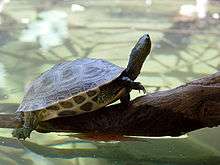Ocadia
| Ocadia | |
|---|---|
 | |
| Chinese stripe-necked turtle Ocadia sinensis | |
| Scientific classification | |
| Kingdom: | Animalia |
| Phylum: | Chordata |
| Class: | Reptilia |
| Order: | Testudines |
| Suborder: | Cryptodira |
| Family: | Geoemydidae |
| Subfamily: | Geoemydinae |
| Genus: | Ocadia Gray, 1870 |
Ocadia is a genus of turtles in the family Geoemydidae (formerly called Bataguridae). It is sometimes included in Mauremys.[1] It contains the following species:
- Chinese stripe-necked turtle, O. sinensis
O. sinensis is known to hybridize with most other Geoemydidae genera.[2] Hybridization runs rampant in that family; while it is possible that perfectly valid species could arise this way, the other Ocadia species are apparently only known from a few specimens each, all of them purchased from a turtle dealer in Hong Kong:
The supposed species "Ocadia glyphistoma", described by Mccord & Iverson in 1994 and supposedly from southern Guangxi and northern Vietnam, is a hybrid between a male O. sinensis and a female Vietnamese pond turtle (Mauremys annamensis).[3] This "species" seems to be naturally occurring in central Vietnam, but is occasionally also bred for the pet trade in southern Chinese turtle farms.[4]
Philippen's striped turtle ("Ocadia philippeni"), described by Mccord & Iverson in 1992 and said to occur on Hainan, also proved to be a hybrid, between a male O. sinensis and a female Cuora trifasciata.[5] It is not proven but likely that this "species" also originates from both the wild and is bred in farms.
In 2013, a Miocene Japanese fossil species of the same genus was described, Ocadia tanegashimensis Takahashi & al.,[6] which adds itself to the already known Pleistocene O. nipponica, from the same country.
References
- ↑ Honad et al. (2002), Feldman & Parham (2004), Spinks et al. (2004)
- ↑ see Vetter & Van Dijk (2006)
- ↑ Spinks et al. (2004), Stuart & Parham (2006)
- ↑ Blanck et al. (in prep.)
- ↑ Stuart & Parham (2006)
- ↑ Akio Takahashi, Kimihiko Ōki, Takahiro Ishido, & Ren Hirayama, 2013, "A new species of the genus Ocadia (Testudines: Geoemydidae) from the middle Miocene of Tanegashima Island, southwestern Japan and its paleogeographic implications"
- Conserv Genet (2007) 8:169–175
- Buskirk, James R.; Parham, James F. & Feldman, Chris R. (2005): On the hybridisation between two distantly related Asian turtles (Testudines: Sacalia × Mauremys). Salamandra 41: 21-26. PDF fulltext
- Parham, James Ford; Simison, W. Brian; Kozak, Kenneth H.; Feldman, Chris R. & Shi, Haitao (2001): New Chinese turtles: endangered or invalid? A reassessment of two species using mitochondrial DNA, allozyme electrophoresis and known-locality specimens. Animal Conservation 4(4): 357–367. HTML abstract Erratum: Animal Conservation 5(1): 86 HTML abstract